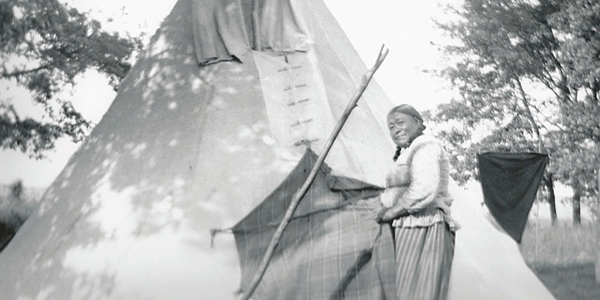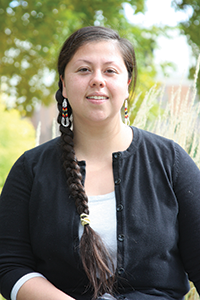
Susan Windgrow, the very special Mdewakanton Dakota woman of great strength and resilience who inspired the establishment of the Susan Windgrow Scholarship for Native American students.
Tradition
Tradition is a belief or behavior passed down within a group or society with symbolic meaning or special significance with origins in the past. For Gail Whipple ‘75, the memory of a very special Mdewakanton Dakota woman of great strength and resilience was the emotional trigger to establishing the Susan Windgrow Scholarship for Native American Students. Whipple shares a Dakota/ Lakota and German lineage, but it wasn’t until her adult years that she came to know, understand, appreciate and love her heritage.
Susan Windgrow, known as Maka Waste’ Win (Good Earth Woman) to her people, was Whipple’s great-great Grandmother. Born in 1845 near what is now the Lower Sioux Reservation in Minnesota, Windgrow survived the Dakota Conflict of 1862, overcoming the loss of family members, her home, and the life she knew. She died at age 94 much as she lived: strong, humble and proud of her people.
Whipple’s Native American lineage wasn’t an integral part of her childhood, and understandably so, when one examines the plight of the American Native people in the 19th century. Whipple grew up in Hastings, Minnesota, the oldest of eight children of Willard (Whip) and Nellie Whipple. Her mother ran a home daycare and her father worked for 3M. But Whipple’s story really begins several generations back…
Erasing a People
The Dakota were a nomadic people who historically relied on wild rice gathering, fishing, and game hunting for sustenance. The Resettlement Treaty of 1837, designed to remove all Native Americans dwelling on the east side of the Mississippi River, effectively diminished the Dakota homeland and their way of life. With less ability to provide for themselves, the Dakota were forced to increasingly depend on the federal government’s promises and provisions. The federal government’s failure to deliver on these promises brought near-starvation and growing anger among the Dakota, culminating in the US-Dakota War of 1862.
Whipple’s paternal grandfather, Ben, was born in 1907 on the Santee Sioux Reservation in Nebraska. Young Ben was removed from his home at Santee and sent to the Indian boarding school in Carlisle, Pennsylvania: “This was common practice in the early 1900s,” Whipple began. “The goal was to take the ‘Indian’ culture out of American Indians. My Grandfather was not allowed to speak his language or practice any traditional activities. When he returned, he had been trained and educated as an American.”
Ben left the Santee and spent time on the Rosebud Reservation in Mission, South Dakota. He married and had a son, Willard. From there the young family moved to Prairie Island Reservation north of Red Wing. Eventually, the family settled off reservation near Hastings, Minnesota, where Whipple grew up and where her parents live to this day.
Heritage Rediscovered
“Native Americans in the early 20th century were taught not to be Native Americans,” Whipple continued. “As a result, my father grew up without many of those traditions and we certainly were not exposed.”
“As a young woman, I began to ask questions of the relatives and began to learn a great deal about our history,” Whipple siad. “As I, and then my brothers and sisters, became more interested, my father opened up about many things in his upbringing and I saw him begin to take pride in his heritage.”
Reflecting on her family’s history, she said, “I grew up not knowing much about my heritage and then grew into an adult who is so proud of my heritage and so grateful to my ancestors, like Grandma Susie, for all they endured and for all they did to survive a very difficult world.”
Path to Success
Whipple remembers her school years as something she simply tolerated. “I wasn’t the kind of kid most people thought of as college material,” Whipple recalled. “My high school years revolved around classes that presumed I would make a great office secretary one day.”
“Algebra befuddled me, chemistry was a monster, and speech class nearly ended my high school career!” said Whipple. “So I muddled through in the top one third of my class. I didn’t embarrass myself, but I certainly didn’t shine as a high school student.”
It was no great surprise when school counselors didn’t recommend Whipple attend college. “My counselors advised against going to college, telling me I just wasn’t cut out for it,” she said. “I was fairly stubborn even then, so after I attended a girls’ sports day at Winona State College when I was in the 9th grade, I decided to apply. To the surprise of many people, I was accepted!”
Funding her education was a real issue, however, as the needs of the large Whipple household were many.
“Because I am an enrolled member of a Federally Recognized Indian Tribe,” Whipple explained, “that opened the door to securing a Bureau of Indian Affairs (BIA) Scholarship. That extra funding made it possible for me to attend college. I spent four years attending classes, making new friends and playing on the volleyball and tennis teams. I owe those four years and what came after, to that scholarship.”
Whipple graduated with a degree in Political Science, and though the road wasn’t always easy, Whipple has no regrets. ”My road has been filled with more joy than bumps, and for that I’m grateful,” she said.
Recently retired, Whipple spent 18 years as Director of Marketing for the Shakopee Mdewakanton Sioux Community in Prior Lake, Minnesota. “I’ve led a staff of graphic designers, web designers, videographers, photographers and copy writers. We handled the marketing efforts of more than a dozen enterprises, and a tribal government. I owe my abilities to think, plan, organize and interact at this level to my years in Winona. It was a time when I learned that I was smarter than I thought, more capable than I knew, and if I worked really hard, anything was possible,” she said.
Whipple wants others to experience an education without “breaking the bank.” “I want to share that hope and that belief in endless opportunity with a Native American student who needs a little help to make their dream of an education come true,” she explained.
“With a degree in-hand, there is absolutely no limit to the possibilities in that young person’s life. To know that I have helped even in a small way will make me very happy.”
Keepers of the Fire

Aaron Camacho is the first recipient of the Susan Windgrow Scholarship for Native American students.
Aaron Camacho, 29, a non-traditional student majoring in environmental biology and minoring in sustainability, is the first recipient of the Susan Windgrow Scholarship for Native American Students.
Camacho is a member of the Prairie Band Potawatomi Nation and thus has dual citizenship as a member of a Sovereign Nation and as a United States Citizen. Her mother is Caucasian and her father is Potawatami (Kansas) Ho Chunk (Wisconsin) and Yaki Indian (Mexican border region). Her family’s story is amazingly similar to her benefactor’s.
Camacho’s ancestors, a nomadic people, lived between Michigan and Wisconsin, moving with the seasons and the wild game. Camacho recalls her grandmother talking of the “Walk of the Dead,” the relocation effort by the U.S. Government to remove Native American tribes from East of the Mississippi River. Camacho’s family was relocated to a reservation in Mayetta, Kansas. Many did not survive the thousand mile trek. “My grandmother said that when her father arrived in Kansas a government employee asked how old he was. Before he could answer, he was told: ‘You are zero. You were born today.’
Much like Whipple’s grandfather, the children in Camacho’s family were placed in boarding schools in Wisconsin and Americanized. In time, the children lost their Native identity. Several families chose to leave the reservation and what little security it provided, and move back to the Upper Midwest, settling in Skunk Hill, just outside Wisconsin Rapids. “They had to learn how to live with others (White Man) and integrate into an entirely new environment,” Camacho said. “It was difficult and they weren’t always accepted.”
Camacho’s early years growing up off reservation nearly mirror those of Whipple’s. “Growing up, I kind of avoided the whole Native American topic,” Camacho began. “I tried to stay below the radar all my life. My parents sheltered my sister and me from the racial implications, afraid we would have a difficult future if we were considered Native. I just didn’t realize the impact living like had on me. The only time we were exposed to our heritage is when I was around my Grandma. She would always tell me, ‘Remember, Aaron, you are Native American!’ I now understand what she was telling me.”
Camacho married just last year and decided to return to school to further her education and to achieve her goal to work in the field of bioremediation of waterways. She discovered Winona State University and together with her husband moved
four hours from family to Fountain City, Wisconsin. I took the plunge!” she said with a laugh.” She sought Tribal funding
to help pay for her education, but still had to work full time. “I felt I had found a very good fit. I was so excited!” she stated.
That is, until she saw the larger-than-life fresco mural gracing the walls in the main entrance of Somsen Hall. “I was stunned at the images,” Camacho related. “It shows Native Americans being Americanized through religion, desecration of the land and progress. There are frightened children and there is death. Then you have what is presumed to be Princess Winonah giving a shawl to a Caucasian man. And in the final scene there are no more Native Americans. I realized it depicts Manifest Destiny,” she said. “There was no plaque to explain the art work and that surprised me. I thought, did I make a mistake coming here? Is this what they think and feel? I am all alone – will I be safe on this campus? I called my husband right away.”
Camacho made a concerted effort to avoid that particular entryway and also the Indian artwork in the Library. But she couldn’t run from it. She was offered a job in the Library.
Camacho made a decision to confront the university about the artwork and began asking questions, which opened up an entirely new dialog on campus about contextualizing the artwork, along with the Native American sculptures, to promote a healthy perspective of Native American people. Turn a negative into a positive. She was invited to sit on a committee to address Native American images on campus, which led to the reframing project and plans for an indigenous garden surrounding the End of the Trail sculpture in the center courtyard. Many felt this sculpture to be depressing and that it evoked feelings of guilt. Camacho disagrees. She recalls always having a small version of this very statue and one other similar in structure in her home growing up. “It is a reminder of how far we’ve all come, and that we continue to persevere,” she stated.
Camacho has immersed herself in campus life and is actively involved in numerous organizations and was elected Student Senator for the College of Engineering. As Camacho became known on campus for her efforts, Professor Colette Hymann got in touch with Whipple to suggest Camacho for the scholarship award. “I can’t believe my professor cared enough to relay my name,” said Camacho.
“I now have a sense of belonging that comes with this scholarship,” Camacho remarked. “Maybe I really am supposed to be here! Knowing there is a Native American Indian scholarship on campus is very empowering. Everything happens for a reason.” Camacho concluded, “Meeting my benefactor at the Scholarship Breakfast was something! She is amazing! There was instant recognition. She understood me.”

